

|
| MAGYARORSZÁG | HUNGARY |
| fãváros: Budapest |
Budapest, situated at an elevation of 102 m on the river Danube, is the capital of Hungary. With a population of over 1.7 million inhabitants (down from a mid-1980s peak of 2.1 million) it is the sixth-largest city of the European Union. Budapest became a single city occupying both banks of the river Danube with the amalgamation in 1873 of right-bank Buda (Ofen in German) and Óbuda (Alt-Ofen) together with Pest on the left (east) bank.
Budapest's recorded history begins with the Roman town of Aquincum, founded around 89 AD on the site of an earlier Celtic settlement near what was to become Óbuda, and from 106 until the end of the 4th century the capital of the province of lower Pannonia. Today's Pest became the site of Contra Aquincum (or Trans Aquincum), a smaller sentry point. The area then became a homeland for the Avars and some Slavic peoples. The area was occupied around the year 900 by the Magyars of Central Asia, who a century later founded the Kingdom of Hungary. Already a place of some significance, Pest recovered rapidly from its destruction by Mongol invaders in 1241, but it was Buda, the seat of a royal castle since 1247, which in 1361 became the capital of Hungary. The Ottoman Empire's conquest of most of Hungary in the 16th century interrupted the cities' growth: Buda and Pest fell to the invaders in 1541. While Buda remained the seat of a Turkish pasha, and administrative center of a whole vilayet, Pest was largely derelict by the time of their recapture in 1686 by Austria's Habsburg rulers, who since 1526 had been Kings of Hungary despite their loss of most of the country.
In the 18th and 18th century it was Pest, a bustling commercial town, which enjoyed the faster growth rate. By 1800 its population was larger than that of Buda and Óbuda combined. The fusion of the three cities under a single administration, first enacted by the Hungarian revolutionary government in 1849 but revoked on the subsequent restoration of Habsburg authority, was finally effected in 1873 by the autonomous Hungarian royal government established under the Austro-Hungarian Ausgleich ("Compromise") of 1867. During the 20th century, most population growth occurred in the suburbs as much of the country's industry came to be concentrated in the city. After World War I, the loss of more than two thirds of the former kingdom's territory (1920) dealt only a temporary blow, leaving Budapest as the capital of a smaller but now fully sovereign state. Between 20% and 40% of Greater Budapest's 250,000 Jewish inhabitants died through Nazi and Arrow Cross genocide during 1944 and early 1945. On 1 January 1950 the area of Budapest was significantly expanded: by attaching 7 cities and 16 towns to the former Budapest, its area enlarged from 207 km² to 525 km², the number of its inhabitants increased from 1.05 million to 1.6 million.
The old city of Budapest was listed as a UNESCO World Heritage site in 1987 (see also list of other UNESCO heritage sites).
[Text adapted from http://hu.wikipedia.org/wiki/Budapest]
| I. kerület: Várkerület | 1st district |
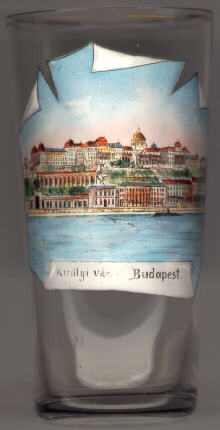
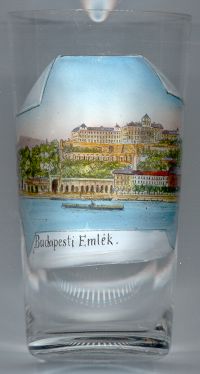 The
The  Royal palace of Buda (Budavári Palota) occupies the southern part of the castle hill. The history of the building goes back to the
13th century, when after 1242 King Béla IV built a castle as his royal residence. Throughout the centuries, many Hungarian sovereigns
added to the palace so that the castle includes Gothic, Renaissance, Baroque parts. During the period of the Turkish occupation of Hungary,
the castle was finally liberated in 1686 after the siege by Duke Karl V of Lorraine. However, the castle had suffered so severe damages that
most parts were demolished and had to be rebuilt alltogether. The construction of the new residence began in 1714 under Emperor Karl VI (Karl III as
King of Hungary) and was completed in in 1770 under the reign of his daughter, Maria Theresia of Austria, Queen of Hungary. The final additions and enlargements
were carried out between 1890 and 1903 in Baroque revival style. During World War II the old cave system under the castle was used as headquarters
of the German Wehrmacht so that the castle came under severe attacks in 1944/1945. Again, almost the whole palace was destroyed. Reconstruction works began
after the war and in 1968 parts of the palace could be re-opened to the public. However, it took another ten years to complete the restoration.
Royal palace of Buda (Budavári Palota) occupies the southern part of the castle hill. The history of the building goes back to the
13th century, when after 1242 King Béla IV built a castle as his royal residence. Throughout the centuries, many Hungarian sovereigns
added to the palace so that the castle includes Gothic, Renaissance, Baroque parts. During the period of the Turkish occupation of Hungary,
the castle was finally liberated in 1686 after the siege by Duke Karl V of Lorraine. However, the castle had suffered so severe damages that
most parts were demolished and had to be rebuilt alltogether. The construction of the new residence began in 1714 under Emperor Karl VI (Karl III as
King of Hungary) and was completed in in 1770 under the reign of his daughter, Maria Theresia of Austria, Queen of Hungary. The final additions and enlargements
were carried out between 1890 and 1903 in Baroque revival style. During World War II the old cave system under the castle was used as headquarters
of the German Wehrmacht so that the castle came under severe attacks in 1944/1945. Again, almost the whole palace was destroyed. Reconstruction works began
after the war and in 1968 parts of the palace could be re-opened to the public. However, it took another ten years to complete the restoration.
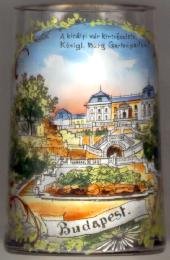
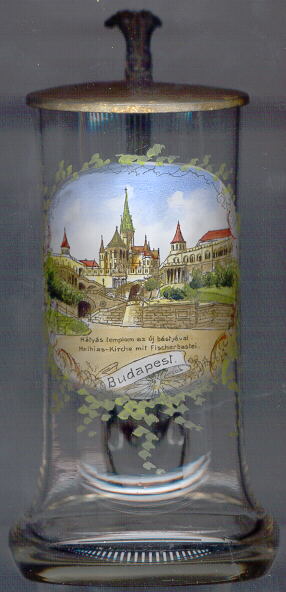
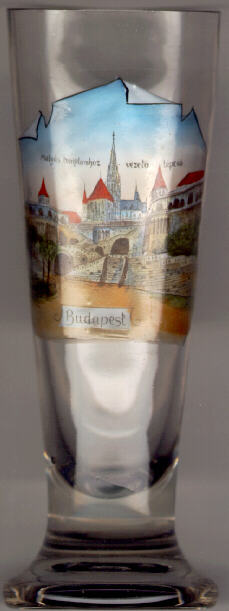
The  church of St. Stephen (Mátyás-templom) (officially called the Church of Our Lady) was built between 1255 and 1269 by King Béla IV
as the first church on the castle hill. At the end of the 14th and beginning of the 15th centuries, it was rebuilt as a Gothic three-naved hall church. Its popular
name goes back to King Hunyadi Mátyás (Matthias Corvinus) who in 1470 ordered the construction of the spire and the royal oratorio.
During the Turkish invasion of 1526, the church was set on fire and fifteen years later converted to the central mosque of Budapest. During the lioberation of Budapest
the church was almost completely destroyed, but was rebuilt in Baroque style by the Franciscan Order. A reconstruction in Gothic revival style was carried out in1873–1896
by the architect Frigyes Schulek. Severely damaged during World War II, the church had to be rebuilt after the war based on Schulek's design.
church of St. Stephen (Mátyás-templom) (officially called the Church of Our Lady) was built between 1255 and 1269 by King Béla IV
as the first church on the castle hill. At the end of the 14th and beginning of the 15th centuries, it was rebuilt as a Gothic three-naved hall church. Its popular
name goes back to King Hunyadi Mátyás (Matthias Corvinus) who in 1470 ordered the construction of the spire and the royal oratorio.
During the Turkish invasion of 1526, the church was set on fire and fifteen years later converted to the central mosque of Budapest. During the lioberation of Budapest
the church was almost completely destroyed, but was rebuilt in Baroque style by the Franciscan Order. A reconstruction in Gothic revival style was carried out in1873–1896
by the architect Frigyes Schulek. Severely damaged during World War II, the church had to be rebuilt after the war based on Schulek's design.
The church was the site of the coronation of Károly Róbert (Karl I Robert of Anjou) (1308) and Zsigmond (Sigismund of Luxembourg) (1385). Béla IV married twice here: in 1463 Catherine of Podiebrad, and after hear death Beatrix of Aragon in 1470. An important political event was also the coronation in 1867 of Franz Joseph I of Austria and his wife Elisabeth as king and queen of Hungary. Franz Liszt composed his Coronation Mass for this event. Franz Joseph's successor, Karl I of Austria, was also crowned here in 1916. In 1936, the church was the site of the first performance of Zoltán Kodály's Te Deum, composed for the 250th anniversary of the liberation of Buda.
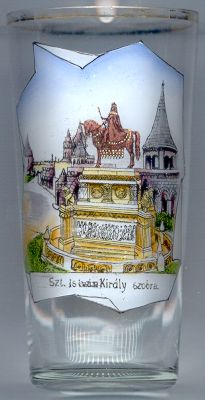
The  Fishermen's Bastion (Halászbástya) [left, no. 2043: background] was built in 1895–1902 by Frigyes Schulek in Romanesque revival
style. During the Middle Ages the location was the site of the fish market. The name was taken from the fishermen's guild which had the duty of defending this section of the
town's fortification.
Fishermen's Bastion (Halászbástya) [left, no. 2043: background] was built in 1895–1902 by Frigyes Schulek in Romanesque revival
style. During the Middle Ages the location was the site of the fish market. The name was taken from the fishermen's guild which had the duty of defending this section of the
town's fortification.
The  statue of St. Stephen (Szent István király szobra), the first Christian king of Hungary, was created in 1906 by the sculptor Alajos Stróbl.
The bronze equestrian statue rests on a neo-Romanesque pedestal designed by Frigyes Schulek.
statue of St. Stephen (Szent István király szobra), the first Christian king of Hungary, was created in 1906 by the sculptor Alajos Stróbl.
The bronze equestrian statue rests on a neo-Romanesque pedestal designed by Frigyes Schulek.
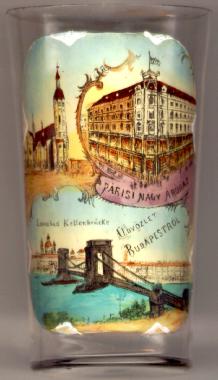
The  church of St. Mary Magdalene (Mária-Magdolna templom) [left, no. 415: top left picture] was built in the 13th century.
During the liberation of Buda in 1686 it was damaged and had to be restored. During World War II the church was almost completely destroyed in 1944/1945. Only the
characteristic spire has survived. The top of the tower is accessible by 163 steps and offers a splendid view over the city.
church of St. Mary Magdalene (Mária-Magdolna templom) [left, no. 415: top left picture] was built in the 13th century.
During the liberation of Buda in 1686 it was damaged and had to be restored. During World War II the church was almost completely destroyed in 1944/1945. Only the
characteristic spire has survived. The top of the tower is accessible by 163 steps and offers a splendid view over the city.
The top right picture on glass no. 415 shows the  Paris Grand Department Store (Párisi Nagy Áruház) in Andrássy út (5th district),
built in 1912.
Paris Grand Department Store (Párisi Nagy Áruház) in Andrássy út (5th district),
built in 1912.
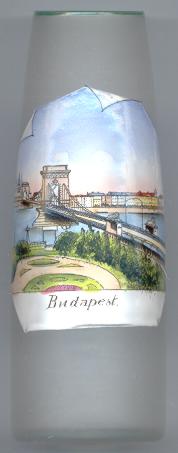
The  Chain Bridge (Széchenyi Lánchíd) [left, no. 415: bottom picture, and right, no. 922],
was built in 1839–1849 and is Budapest's oldest bridge across the Danube. At the time of its construction
it was the first bridge across the Danube downstream of Regensburg.
The bridge connects the right bank of the river below the castle hill (1st district) with the square, Roosevelt tér, on the left bank (5th district).
The bridge has a length of 375 m, suspended by iron chains. The bridge is named for the Hungarian reformer Count István Széchenyi who in 1832 had founded an
association to promote the bridge. The original iron bridge was reinforced in 1900. During World War II it was blown up, like all the other Danube bridges,
by the retreating German army. The reconstructed bridge was re-opened on 21 November 1949, the day of the 100th anniversary of its first inauguration.
Chain Bridge (Széchenyi Lánchíd) [left, no. 415: bottom picture, and right, no. 922],
was built in 1839–1849 and is Budapest's oldest bridge across the Danube. At the time of its construction
it was the first bridge across the Danube downstream of Regensburg.
The bridge connects the right bank of the river below the castle hill (1st district) with the square, Roosevelt tér, on the left bank (5th district).
The bridge has a length of 375 m, suspended by iron chains. The bridge is named for the Hungarian reformer Count István Széchenyi who in 1832 had founded an
association to promote the bridge. The original iron bridge was reinforced in 1900. During World War II it was blown up, like all the other Danube bridges,
by the retreating German army. The reconstructed bridge was re-opened on 21 November 1949, the day of the 100th anniversary of its first inauguration.
Before the construction of the bridge, the two banks of the river were only connected by a pontoon bridge which had to be dismantled every year before winter. At the time, bridges in continental Europe were exclusively built out of wood or stone, but nobody dared to construct a bridge out of these materials across a river as wide as the Danube which in winter carried vast amounts of ice. Only the use of iron, which at that time was already used in England, permitted the construction. Szécheny never actually was able to see the completed church as he suffered a nervous breakdown in 1848 and spent the rest of his life in the asylum of Döbling, Vienna.
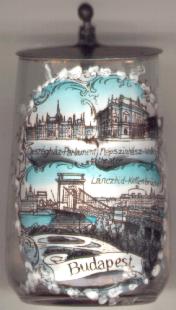
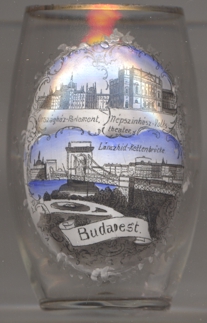
Glasses no. 3997 and 479 [near right] both show the identical views of:
the Parliament building [top left],
the National Theatre [top right],
and the Chain Bridge [bottom].
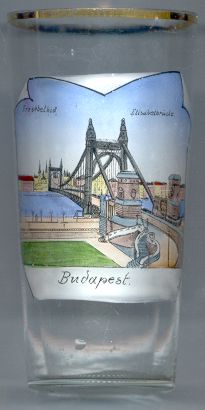
The  Elisabeth Bridge (Erzsébet híd) was the fourth bridge across the Danube in Budapest. The original bridge, a chain bridge construction,
was built in 1898–1903 and was named for Elisabeth of Austria and Hungary, wife of Emperor Franz Joseph I. The bridge had a span of 260 m
and at the time of its construction it was the world's longest suspension bridge. After its blasting in 1945,
it is the only bridge in Budapest that was not reconstructed to the original design. A new, modern bridge was built only in 1960–1964.
Elisabeth Bridge (Erzsébet híd) was the fourth bridge across the Danube in Budapest. The original bridge, a chain bridge construction,
was built in 1898–1903 and was named for Elisabeth of Austria and Hungary, wife of Emperor Franz Joseph I. The bridge had a span of 260 m
and at the time of its construction it was the world's longest suspension bridge. After its blasting in 1945,
it is the only bridge in Budapest that was not reconstructed to the original design. A new, modern bridge was built only in 1960–1964.
| II. kerület | 2nd district |
(see also list of other basilicae minores depicted on glasses of this collection)
Pesthidegkút (German: Hidikut), first mentioned in 1255, was incorporated into Budapest in 1950 and is part of the city's 2nd district.
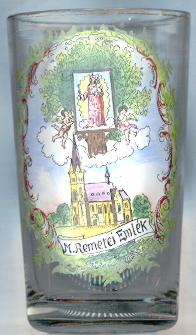
The  pilgrimage church Mária Remete (Our Lady in Recluse) (German: Maria-Einsiedel) [left] near Pesthidegkút was built in 1899.
It is one of the Hungarian Catholics' favourite Marian shrines. the pilgrimages to this site go back at least to the early 17th century.
The church gained the status of a Basilica minor in 1991.
pilgrimage church Mária Remete (Our Lady in Recluse) (German: Maria-Einsiedel) [left] near Pesthidegkút was built in 1899.
It is one of the Hungarian Catholics' favourite Marian shrines. the pilgrimages to this site go back at least to the early 17th century.
The church gained the status of a Basilica minor in 1991.
| IV. kerület: Újpest | 4th district |
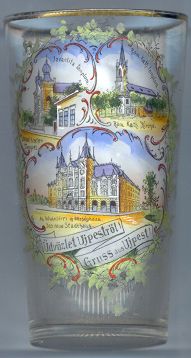
The  Újpest Synagogue (Újpesti Zsinagóga) [left, no. 1971: top left picture]
inaugurated in 1886 and has recently been renovated.
Újpest Synagogue (Újpesti Zsinagóga) [left, no. 1971: top left picture]
inaugurated in 1886 and has recently been renovated.
The other two buildings depicted on glass no. 1971 are:
 Roman Catholic church [top right] (unidentified), and
Roman Catholic church [top right] (unidentified), and
 Újpest Town Hall (Újpest városháza) [bottom].
Újpest Town Hall (Újpest városháza) [bottom].
The village of Újpest was founded in 1840. By 1870 Újpest became a village with the largest population in Hungary (10,000 inhabitants), with significant industry.
In 1907 the village was granted the privileges of a town with "organized council". On 1 January 1950 Újpest was incorporated into Budapest.
| V. kerület | 5th district |
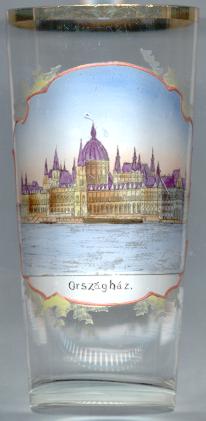
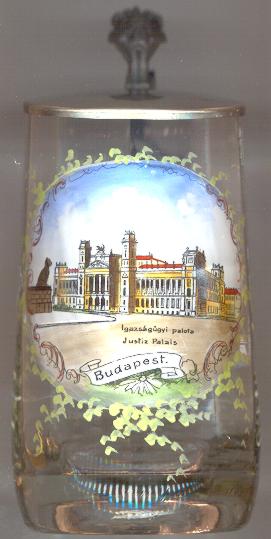
The  Hungarian Parliament Building (Országház) [left, no. 665] is the seat of the National Assembly of Hungary. Seven years after the cities of Buda, Pest and Óbuda
were merged in 1873, the National Assembly resolved to establish a new, representative Parliament Building, expressing the sovereignty of the nation.
A competition was published, which was won by Imre Steindl. The construction of the parliament was started in 1885, inaugurated in the millennium anniversary of
the country in 1896, and was completed in 1904.
Hungarian Parliament Building (Országház) [left, no. 665] is the seat of the National Assembly of Hungary. Seven years after the cities of Buda, Pest and Óbuda
were merged in 1873, the National Assembly resolved to establish a new, representative Parliament Building, expressing the sovereignty of the nation.
A competition was published, which was won by Imre Steindl. The construction of the parliament was started in 1885, inaugurated in the millennium anniversary of
the country in 1896, and was completed in 1904.
The building in a Gothic revival style is 268 m long and 123 m wide. Its interior includes 10 courtyards, 27 gates, 29 staircases and 691 rooms. With its height of 96 m, it is the tallest building of Budapest, along with Saint Stephen's Basilica. The number 96 refers to the nation's millennium, 1896, and the conquest of the later Kingdom of Hungary in 896 AD.
The former  Palace of Justice (Igazságügyi Palota) [right, no. 901] was built in 1893–1896 by the architect Alajos Hauszmann.
It is located in Kossuth Lájos tér, next to the Parliament building. The building was severely damaged in World War II and was renovated after the war.
The Hungarian Supreme Court moved out of the building in 1949. From 1950 the building was home to the Institute for the History of the Labour Movement.
Between 1957 and 1973 it was the temporary home of the new Hungarian National Gallery. When the museum moved to Buda Castle, the
building became the home of the Museum of Ethnography (Néprajzi Múzeum).
Palace of Justice (Igazságügyi Palota) [right, no. 901] was built in 1893–1896 by the architect Alajos Hauszmann.
It is located in Kossuth Lájos tér, next to the Parliament building. The building was severely damaged in World War II and was renovated after the war.
The Hungarian Supreme Court moved out of the building in 1949. From 1950 the building was home to the Institute for the History of the Labour Movement.
Between 1957 and 1973 it was the temporary home of the new Hungarian National Gallery. When the museum moved to Buda Castle, the
building became the home of the Museum of Ethnography (Néprajzi Múzeum).
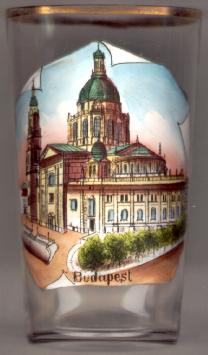
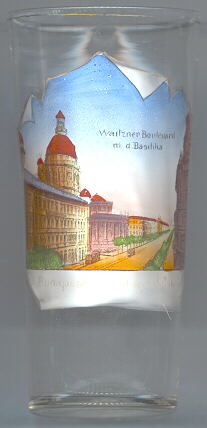
The  basilica of St. Stephen (Szent István-bazilika) is the largest church of Budapest.
The construction was initially begun in 1848 but had to be interrupted in the same year as this was the period of the Hungarian struggle for independence.
One of the major problems for the building was the location near the Danube river, which afforded extensive foundations. The construction finally started in 1851.
Its first architect was József Hild who had designed a building in Classicist style. Hild died in 1867 and one year later the cupola collapsed due to faulty
foundations. The building was then continued, in a Renaissance revival style, by Miklós Ybl. After Ybl's death in 1891 the church was completed by József Kauser.
The basilica was finally consecrated in 1905, and in 1931 it was awarded the title Basilica minor by the Holy See.
basilica of St. Stephen (Szent István-bazilika) is the largest church of Budapest.
The construction was initially begun in 1848 but had to be interrupted in the same year as this was the period of the Hungarian struggle for independence.
One of the major problems for the building was the location near the Danube river, which afforded extensive foundations. The construction finally started in 1851.
Its first architect was József Hild who had designed a building in Classicist style. Hild died in 1867 and one year later the cupola collapsed due to faulty
foundations. The building was then continued, in a Renaissance revival style, by Miklós Ybl. After Ybl's death in 1891 the church was completed by József Kauser.
The basilica was finally consecrated in 1905, and in 1931 it was awarded the title Basilica minor by the Holy See.
The building is 86 m long, 55 m wide, 96 tall and covers an of 4,147 m². It offers seating for 8,500 persons. The right tower houses the country's biggest bell weighing 9 tonnes.
The most important relic that is guarded in the church is the embalmed right hand of St Stephen. The relic is kept in the chapel of St. Leopold and is paraded each year on the 20th of August.
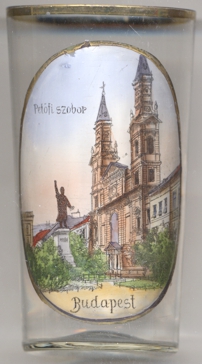
The  Russian Orthodox Cathedral of Our Lady [near left, no. 4577: right]
was built in 1791–1801. One of its towers collapsed in 1945 in during the siege of Budapest towards the end of World War II. The façade was restored in
1953 and the tower was rebuilt in 2008.
Russian Orthodox Cathedral of Our Lady [near left, no. 4577: right]
was built in 1791–1801. One of its towers collapsed in 1945 in during the siege of Budapest towards the end of World War II. The façade was restored in
1953 and the tower was rebuilt in 2008.
[https://hu.wikipedia.org/wiki/Istensz%C3%BCl%C5%91_elhunyta_Nagyboldogasszony-sz%C3%A9kesegyh%C3%A1z_(Budapest)]
The  monument fo Sándor Petőfi [near left, no. 4577:foreground left]
was created in 1882 by the sculptor Miklós Izsó. Petőfi, né Petrovics, was a Hungarian poet and liberal revolutionary. He is
considered Hungary's national poet, and was one of the key figures of the Hungarian Revolution of 1848. He is the author of the Nemzeti dal
(National Song), which is said to have inspired the revolution in the Kingdom of Hungary that grew into a war for independence within the Austrian Empire.
It is most likely that he died in the Battle of Segesvár, one of the last battles of the war.
monument fo Sándor Petőfi [near left, no. 4577:foreground left]
was created in 1882 by the sculptor Miklós Izsó. Petőfi, né Petrovics, was a Hungarian poet and liberal revolutionary. He is
considered Hungary's national poet, and was one of the key figures of the Hungarian Revolution of 1848. He is the author of the Nemzeti dal
(National Song), which is said to have inspired the revolution in the Kingdom of Hungary that grew into a war for independence within the Austrian Empire.
It is most likely that he died in the Battle of Segesvár, one of the last battles of the war.
[https://hu.wikipedia.org/wiki/Pet%C5%91fi_S%C3%A1ndor-szobor_(Budapest);
https://en.wikipedia.org/wiki/S%C3%A1ndor_Pet%C5%91fi]
| VI. kerület: Terézváros | 6th district |
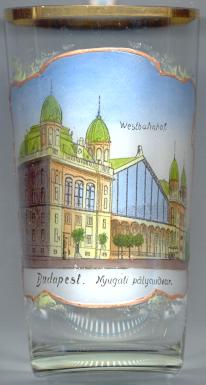
The  Western Railway Station (Nyugati Pályaudvar) [left] is one of the two major stations in Budapest.
The first steam engine to run in Hungary had left Budapest from this place in 1846. At that time the line ended 35 km to the north, at Vác.
The present station building was planned by Auguste de Serres and was built in 1874–1877 by the Eiffel company, who would become famous several years later when they
constructed the Eiffel Tower in Paris. The construction was especially challenging, because the train traffic had to go be left undisturbed
so that it was decided to build the new station atop the old one. After the openeng of the new station, the old building was demolished to make way for the
Grand Boulevard (Nagykörút).
Western Railway Station (Nyugati Pályaudvar) [left] is one of the two major stations in Budapest.
The first steam engine to run in Hungary had left Budapest from this place in 1846. At that time the line ended 35 km to the north, at Vác.
The present station building was planned by Auguste de Serres and was built in 1874–1877 by the Eiffel company, who would become famous several years later when they
constructed the Eiffel Tower in Paris. The construction was especially challenging, because the train traffic had to go be left undisturbed
so that it was decided to build the new station atop the old one. After the openeng of the new station, the old building was demolished to make way for the
Grand Boulevard (Nagykörút).
| VIII. kerület: Józsefváros | 8th district |
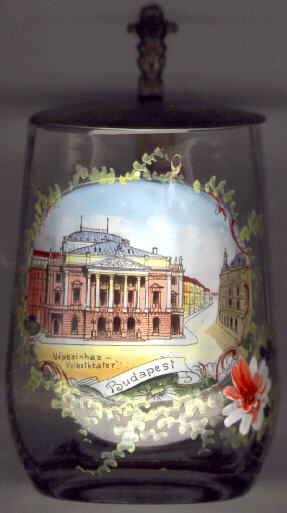
 National Theatre (Népszínház) (German: Volkstheater) [left, no. 117] was built in 1874–1875 as a private theatre for the
"Volkstheater AG" (National Theatre Inc.) by the architects Ferdinand Fellner and Hermann Helmer. The theatre had 2,400 seats. From 1908 until 1964 it was home
to the Nemszeti Színház (National Theatre) drama company. The building was demolished in 1965 during the construction of an underground train system.
National Theatre (Népszínház) (German: Volkstheater) [left, no. 117] was built in 1874–1875 as a private theatre for the
"Volkstheater AG" (National Theatre Inc.) by the architects Ferdinand Fellner and Hermann Helmer. The theatre had 2,400 seats. From 1908 until 1964 it was home
to the Nemszeti Színház (National Theatre) drama company. The building was demolished in 1965 during the construction of an underground train system.
(See also list of further buildings by Fellner and Helmer that are depicted on glasses of this collection.)
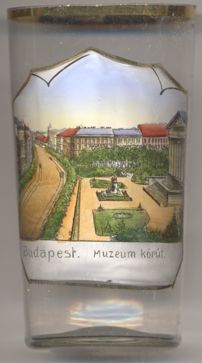
Glass no. 4468 [left] is labeled in Hungarian Múzeum körút ('Museum Belt (Road)'), the
representative avenue at the border between Budapest's 1st and 8th district. The avenue is named for the
 Hungarian
Hungarian
[https://en.wikipedia.org/wiki/Hungarian_National_Museum]
The monument depicted in the centre of the picture, in front of the entrance of the museum, is the
 monument
monument
| XIV. kerület: Zugló | 14th district |
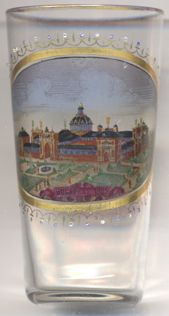
 Industrial Hall [left, no. 4572] was one of he main buildings that were created for the
Hungarian State Exhibition of 1885. The design was chosen following an architectural competition, which was won by the Austrian architect
Christian Ulrich. The exhibition lasted from 2 May until the end of October of 1885 and took place in Városliget ('City Park').
The building was demolished in 1947.
The area of the City Park was already mentioned in 1241. The first trees and planned walkways were established in 1751 and after the public park
was created in the first decades of the 19th century the present-day name, Városliget (and its German version, Stadtwäldchen)
was accepted and it became one of the first public parks in the world.
Industrial Hall [left, no. 4572] was one of he main buildings that were created for the
Hungarian State Exhibition of 1885. The design was chosen following an architectural competition, which was won by the Austrian architect
Christian Ulrich. The exhibition lasted from 2 May until the end of October of 1885 and took place in Városliget ('City Park').
The building was demolished in 1947.
The area of the City Park was already mentioned in 1241. The first trees and planned walkways were established in 1751 and after the public park
was created in the first decades of the 19th century the present-day name, Városliget (and its German version, Stadtwäldchen)
was accepted and it became one of the first public parks in the world.
![[scale]](lineal.jpg)